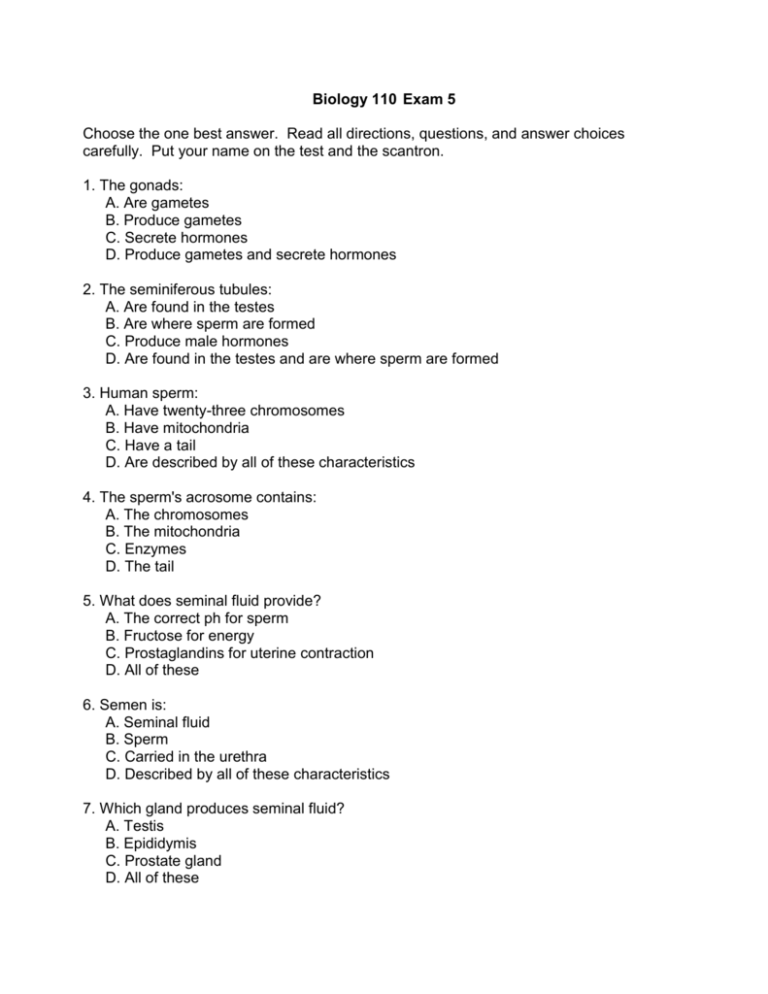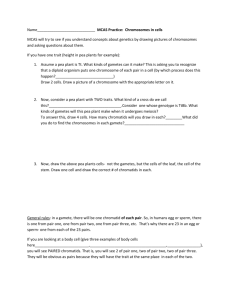Bio 110 Exam 5 Practice
advertisement

Biology 110 Exam 5 Choose the one best answer. Read all directions, questions, and answer choices carefully. Put your name on the test and the scantron. 1. The gonads: A. Are gametes B. Produce gametes C. Secrete hormones D. Produce gametes and secrete hormones 2. The seminiferous tubules: A. Are found in the testes B. Are where sperm are formed C. Produce male hormones D. Are found in the testes and are where sperm are formed 3. Human sperm: A. Have twenty-three chromosomes B. Have mitochondria C. Have a tail D. Are described by all of these characteristics 4. The sperm's acrosome contains: A. The chromosomes B. The mitochondria C. Enzymes D. The tail 5. What does seminal fluid provide? A. The correct ph for sperm B. Fructose for energy C. Prostaglandins for uterine contraction D. All of these 6. Semen is: A. Seminal fluid B. Sperm C. Carried in the urethra D. Described by all of these characteristics 7. Which gland produces seminal fluid? A. Testis B. Epididymis C. Prostate gland D. All of these 8. Which is involved with the functioning of the testes? A. Hypothalamus B. Anterior pituitary gland C. Gonadotropic hormones D. All of these 9. Testosterone: A. Matures sperm B. Is responsible for male secondary characteristics C. Causes oil glands to secrete D. Is described by all of these characteristics 10. Follicles are found in: A. The ovaries B. The testes C. The ovaries and testes D. Neither the ovaries nor testes 11. When a follicle loses an egg, it becomes a: A. Graafian B. Corpus luteum C. Zona pellucida 12. Where does oogenesis occur? A. In the corpus luteum B. In the follicle C. In the epididymis D. In the uterus 13. Which layer of the uterus varies according to the monthly reproductive cycle? A. Endometrium B. Myometrium C. Perimetrium D. All of these 14. Which of the following is an external genital organ of the female? A. Vulva B. Labia minora C. Clitoris D. All of these 15. The pregnancy test is based on the fact that: A. LH is present in the blood B. Progesterone is present in the blood C. HCG is present in the blood D. All of these are correct 16. Which hormone(s)is (are) needed for milk production? A. Prolactin B. Oxytocin C. Colostrum D. Prolactin and oxytocin E. All of these 17. During menstruation the: A. Follicle breaks down B. Endometrium breaks down C. Epididymis breaks down D. Alveoli break down 18. Embryonic development: A. Refers to the first two months B. Refers to months three to nine C. Consists of the refinement of the major organs D. Is described by all of these characteristics 19. Cleavage: A. Is cell division B. Is mitosis C. Occurs immediately after fertilization D. Is described by all of these characteristics 20. Morphogenesis refers to: A. Increase of size B. Shaping of the embryo C. Cells having a specific function D. All of these 21. At the placenta: A. Oxygen enters the fetal circulation B. Nutrients enter the fetal circulation C. Nitrogenous wastes enter maternal circulation D. All of these events occur 22. The umbilical cord contains: A. The fetal intestine B. Blood vessels C. Only muscle tissue D. The fetal intestine and muscle tissue 23. Which causes uterine contractions? A. Prostaglandins B. Oxytocin C. HCG D. Prostaglandins and oxytocin E. All of these 24. What is the difference between ovulation, fertilization, and pregnancy? A. Ovulation is the maturation of an egg in the ovary B. Ovulation can occur without fertilization but pregnancy can’t occur without ovulation C. Pregnancy is the fusion of the egg nucleus with a sperm nucleus D. Pregnancy doesn’t require implantation but fertilization does 25. Which extraembryonic membrane provides a fluid environment for the development of the embryo and fetus? A. The yolk sac B. The allantois C. The chorion D. The amnion 26. What is the difference between cleavage and growth? A. Cleavage occurs in a developing zygote whereas growth occurs in an embryo B. Cleavage causes increases in cell number, but not an increase in size C. A developing embryo increases in both cell number and size D. All of the above are true 27. Which of the following conditions may affect premature babies? A. Respiratory distress syndrome B. Retinopathy of prematurity C. Jaundice D. Circulatory disorders E. All of the above 28. What is a breech birth? A. The baby arrives rump first B. The same thing as a cesarean section C. A birth that requires forceps to aid delivery D. A birth in which a vacuum extractor is utilized 29. Autosomes are: A. Human chromosomes B. Sex chromosomes C. Nonsex chromosomes D. Human sex chromosomes 30. A human female body cell contains: A. 46 chromosomes B. 44 autosomes C. 2 X chromosomes D. All of these 31. Down syndrome is due to an extra: A. X chromosome B. Y chromosome C. Autosome D. X chromosome or an extra Y chromosome. 32. The sex of a child is determined by the: A. Sperm B. Egg C. Either sperm or egg 33. Which sex chromosome(s) is(are)needed for life? A. X B. Y C. X and Y 34. In which situation can a child born with a genetic disease have two normal parents? A. When the disease gene is dominant B. When the disease gene is recessive C. When the disease gene is either dominant or recessive D. It is not possible 35. A sex-linked gene inherited by a male comes from the: A. Father B. Mother C. Father or the mother D. Father and the mother 36. Males are more likely to have a sex-linked disorder than females. Why does this happen? A. Males only have one X chromosome and therefore express (show the effects of) all X-linked genes B. Most sex-linked disorders are carried on the Y chromosome C. Males are the weaker sex D. Females with sex-linked disorders tend to die in utero









